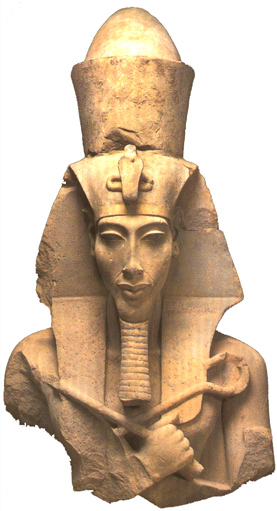top Akhenaten was an ancient Egyptian pharaoh of the 18th Dynasty who ruled for years and died perhaps in 1336 BC or 1334 BC. He is noted for abandoning traditional Egyptian polytheism and introducing worship centered on the Aten, which is sometimes described as monolatristic, henotheistic, or even quasi-monotheistic. An early inscription likens the Aten to the sun as compared to stars, and later official language avoids calling the Aten a god, giving the solar deity a status above mere gods.
Made in Egypt
Akhenaten statue gold
Antique Art Sculpture
Brand: Onuris
We ship within three business days of payment, usually sooner.
Shipping service DHL Express. We accept payment by PayPal method
Customer satisfaction is very important to us.
If you have any problem with your order,
please contact us and we will do our best to make you satisfied.
Please visit our store to check out other items for sale!
Thank you for shopping at Onuris store.
History
Akhenaten tried to shift his culture from Egypt's traditional religion, but the shifts were not widely accepted. After his death, his monuments were dismantled and hidden, his statues were destroyed, and his name excluded from the king lists. Traditional religious practice was gradually restored, and when some dozen years later rulers without clear rights of succession from the 18th Dynasty founded a new dynasty, they discredited Akhenaten and his immediate successors, referring to Akhenaten himself as "the enemy" or "that criminal" in archival records.
He was all but lost from history until the discovery during the 19th century of the site of Akhetaten, the city he built and designed for the worship of Aten, at Amarna. Early excavations at Amarna by Flinders Petrie sparked interest in the enigmatic pharaoh, and a mummy found in the tomb KV55, which was unearthed in 1907 in a dig led by Edward R. Ayrton, is likely that of Akhenaten. DNA analysis has determined that the man buried in KV55 is the father of King Tutankhamun, but its identification as Akhenaten has been questioned.
Modern interest in Akhenaten and his queen Nefertiti comes partly from his connection with Tutankhamun (even though Tutankhamun's mother was not Nefertiti, but a woman named by archaeologists The Younger Lady), partly from the unique style and high quality of the pictorial arts he patronized, and partly from ongoing interest in the religion he attempted to establish.
Product code: Egyptian statue of Akhenaten sun top god aten (Amenhotep IV) gold made in egypt




